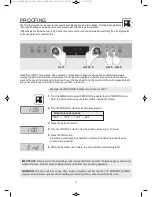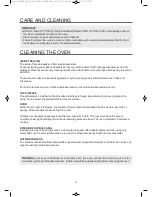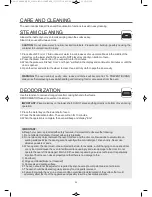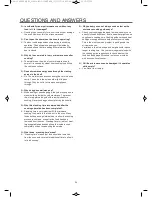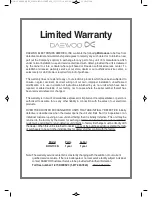
GENERAL GUIDELINES
28
Since microwave cooking is to some extent different
from traditional cooking, the following general
guidelines should be considered whenever you use
your microwave oven:
If the food is undercooked
Check to see if:
• You have selected the correct power level.
• The selected time is sufficient. The times given in
the recipes are approximate. They depend on initial
temperature, weight and density of the food.
• The container is appropriate.
If the food is overcooked
(eg dried out or burnt)
Before you cook again, consider whether:
• The power level was too high.
• The set time was too long-the times in the recipes
are approximate. They depend on initial
temperature, weight and density of the food.
Points to remember when defrosting
• The shape of the package alters the defrosting time.
Shallow rectangular packets defrost more quickly
than a deep block. Separate pieces as they begin to
defrost. Loosely arranged slices defrost more easily.
• Shield areas of food with small pieces of foil if they
start to become warm.
• When defrosting, it is better to under thaw the food
slightly and allow the process to finish during the
standing time.
The amount of food
The more food you want to prepare the longer it
takes. A rule of thumb is that double amount of food
requires almost double the time. If one potato takes
four minutes to cook, approximately seven minutes
are required to cook two potatoes.
Starting temperature of food
The lower the temperature of the food which is being
put into the microwave oven, the longer time it takes.
Food at room temperature will be heated more
quickly than food at refrigerator temperature.
Composition of the food
Food with a lot of fat and sugar will be heated faster
than food containing a lot of water. Fat and sugar will
also reach a higher temperature than water in the
cooking process.
The more dense the food, the longer it takes to heat.
“Very dense” food like meat takes longer time to
reheat than lighter, more porous food like sponge
cakes.
Size and shape
Smaller pieces of food will cook more quickly than
larger pieces and uniform pieces of food cook more
evenly than irregularly shaped foods.
With unevenly shaped food, the thinner parts will
cook faster than the thicker areas. Place the thinner
chicken wings and legs to the center of the dish.
Stirring, turning of foods
Stirring and turning of foods are techniques used in
conventional as well as in microwave cooking to
distribute the heat quickly to the center of the dish to
avoid over-cooking at the outer edges of the food.
Covering food helps
• To reduce spattering
• To shorten cooking times
• To retain food moisture
All covering, which will allow microwaves to pass
through are suitable. See “Which utensils can be
used in the oven?”
Releasing pressure in foods
Several foods are tightly covered by a skin or
membrane. These foods should be pierced with a
fork or cocktail stick to release the pressure and to
prevent bursting as steam builds up within them
during cooking. This applies to potatoes, chicken
livers, sausages, egg yolks and some fruits.
Standing time
Always allow food to stand for some time after using
the oven. Standing time after defrosting,cooking or
reheating usually improves the result since the
temperature will then be evenly distributed through
out the food.
In a microwave oven foods continue to cook even
when the microwave energy is turned off. While they
are no longer cooking by microwaves, they are still
being cooked by the conduction of the high residual
heat to the center of the food.
The length of standing time depends on the volume
and density of the food. Sometimes it can be as short
as the time it takes you to remove the food from the
oven and take it to the serving table. However, with
larger, denser foods, the standing time may be as
long as 10 minutes. During ‘standing’, the internal
temperature of the food will rise by as much as 45
˚
F
and the food will finish cooking in this time.
28
KOC-1C4K5AV0_REV_110214:KOC-1C4K5AV0_(㦖_㦖㦖㦖) 2011-02-14 오 7:15 페이지 28














